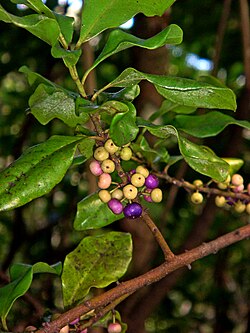Biology:Myrsine kermadecensis
| Myrsine kermadecensis | |
|---|---|

| |
| Scientific classification | |
| Kingdom: | Plantae |
| Clade: | Tracheophytes |
| Clade: | Angiosperms |
| Clade: | Eudicots |
| Clade: | Asterids |
| Order: | Ericales |
| Family: | Primulaceae |
| Genus: | Myrsine |
| Species: | M. kermadecensis
|
| Binomial name | |
| Myrsine kermadecensis Cheeseman, 1892[1]
| |
| Synonyms[2] | |
| |
Myrsine kermadecensis, commonly known as the Kermadec matipo, Kermadec myrsine, or the Kermadec mapou, is a species of flowering plant in the family Primulaceae, edemic to the Kermadec Islands of New Zealand. It was named by Thomas Cheeseman in 1888, and first described in 1892.[2][3]
Taxonomy
Cheeseman named the species in his 1888 article On the flora of the Kermadec Islands; with Notes on the Fauna, noting that the plant was common on Raoul Island, but refused to describe it as a novel species until he was able to compare with specimens of Myrsine crassifolia from Norfolk Island.[3] Cheeseman described the plant four years later, in his article On some Recent Additions to the New Zealand Flora (1892).[1]
Description
Myrsine kermadecensis on average reaches 10 m (32.80 feet) tall, rounded crown, with rough, firm bark. Leaves are 3–7 cm (1.18-2.75 inches) long, and 1–3.5 cm (0.39-1.37 inches) wide. Flowers are green-yellow with purple spotting, or a darker red with purple spotting. Fruit are 6–9 mm (0.23-0.35 inches) wide.[4] Cheeseman described the species as follows:
A small glabrous tree, with much of the habit and appearance of Drimys axillaris. Bark rough, blackish - brown. Leaves 2in.-2 1⁄2in. long, obovate-oblong, acute or obtuse, entire, coriaceous, gradually narrowed into short petioles 1⁄6in.-1⁄4in. long; margins slightly recurved. Flowers small, diœcious (or polygamous?) in many-flowered clusters on the old wood below the leaves. Pedicels short, rarely over 1⁄5in. Calyx minute, lobes short, broad. Corolla about 1⁄8in. long, divided nearly to the base into 5 acute lobes, which are fringed at the sides. Anthers nearly as large as the lobes. Drupe globose, 1⁄3in.-1⁄4in. diameter, black when fully ripe.[1]
Cheeseman noted that the plant was phenotypically similar to both Myrsine crassifolia and Myrsine variabilis of Australia; with Myrsine kermadecensis having smaller leaves and longer petioles than Myrsine crassifolia.[1]
When the genus Myrsine was formerly separated into Rapanea and Suttonia, Cheeseman published this further description posthumously in 1925:
A small glabrous tree 8—15 ft. high; bark rough, blackish-brown. Leaves 1 1⁄2-2 1⁄2 in. long, elliptic-oblong or obovate-oblong, acute or obtuse, narrowed into petioles 1⁄6-1⁄4 in. long, entire, coriaceous, glandular-dotted, veins copiously reticulated, margins slightly recurved. Flowers in many-flowered fascicles on the old wood below the leaves, small, 1⁄10-1⁄8 in. diam., unisexual; pedicels short, 1⁄8-1⁄6 in. long. Calyx minute, 4-5-lobed; lobes short, broad. Corolla divided nearly to the base into 4 or 5 ovate acute lobes, which are fringed on the margins. Anthers nearly as large as the lobes. Female flowers not seen. Fruit globose, 1⁄4-1⁄3 in. diam., black when fully ripe, 1-seeded.[5]
Distribution and habitat
Myrsine kermadecensis is endemic to Raoul Island, Kermadec Islands,[4] where it grows in the subtropical biome,[2] primarily in drier-climate forests, but also is occasionally seen growing within wetter forests.[4]
Conservation
No official conservation status has been assigned to the species by the IUCN Red List yet, for it is generally out of reach within its smaller-sized range.[4]
Uses
Myrsine kermadecensis has no currently listed uses, although its berries are edible and may have been eaten by the Polynesians who arrived on the island in the 14th century.[4]
References
- ↑ 1.0 1.1 1.2 1.3 , Wikidata Q115588197
- ↑ 2.0 2.1 2.2 "Myrsine kermadecensis Cheeseman | Plants of the World Online | Kew Science" (in en). http://powo.science.kew.org/taxon/urn:lsid:ipni.org:names:589151-1.
- ↑ 3.0 3.1 , Wikidata Q115586437
- ↑ 4.0 4.1 4.2 4.3 4.4 "Myrsine kermadecensis" (in en). https://www.nzpcn.org.nz/flora/species/myrsine-kermadecensis/.
- ↑ , p. 711, Wikidata Q115528659
Wikidata ☰ Q17251875 entry
 |


